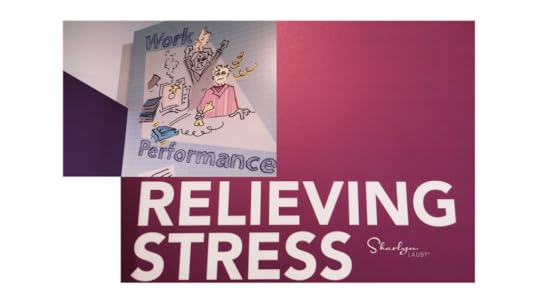Sharlyn J. Lauby's Blog, page 50
August 11, 2022
Employee Burnout Is an Organizational Issue Job Rejection Emails: Are They Necessary –� HR BartenderEmployee Burnout Is an Organizational Issue – HR Bartender

Estimated reading time: 3 minutes
I saw an article on Lifehacker recently titled, “How You Should Respond to a Job Rejection Email”. The article was focused on whether candidates should send a response to a job rejection from a company.
But the article got me thinking about rejection emails in general. First, organizations should always close the loop with applicants and candidates. ALWAYS! Today’s technologies allow organizations to send applicants and candidates emails to let them know their status in the process. There’s no reason not to.
I’d take this one step further and say organizations have an obligation to do more than send an email to internal candidates. At this point, it’s not about recruitment. Letting an internal candidate know that they are no longer being considered is a development conversation. The employee wants to know that the organization is going to support their future development.
So, organizations definitely need to send rejection emails or have close the loop conversations.
Now, on the employee side. I’m torn about sending a reply to a rejection email. Individuals should ask themselves, “What’s the goal?”. If you’re trying to keep the door open with this organization, then yes, a response could be appropriate. In the case of an internal candidate, it could make some sense to follow up and let the organization know that you take their feedback seriously.
But individuals might find that writing a response doesn’t make sense with every job rejection letter they receive. Sometimes during the interview process candidates learn that they really don’t want to work for that company and the job rejection letter is a relief.
If you’re planning to write a response to a rejection email, here are a few things to consider:
Make the reply sound like you versus a form letter. This is especially true if you want to be considered for other jobs. Keep it brief and to the point. Mention why you are worth considering again in the future. If you’re applying for a job where you have transferrable skills – meaning skills that would be valuable in many different positions – this could be worth touching on. Thank the company for their consideration.While it might be tempting to comment on the company’s hiring processes, think carefully before sharing your frustrations. As a human resources professional, I understand that sometimes the interview process is frustrating. The process takes too long. There were multiple interviews. Only to find out at the end that you weren’t selected. Again, you must decide, “What’s the goal?”. Burning a bridge might make you feel better, but not be good for your job search or your career.
Ultimately, remember that the value in sending or responding to a job rejection email is to stand out – in a good way. Remember that.
Image captured by Sharlyn Lauby while exploring the streets of Austin, TX
The post Job Rejection Emails: Are They Necessary – HR Bartender appeared first on hr bartender.
Job Rejection Emails: Are They Necessary – HR Bartender

Estimated reading time: 3 minutes
I saw an article on Lifehacker recently titled, “How You Should Respond to a Job Rejection Email”. The article was focused on whether candidates should send a response to a job rejection from a company.
But the article got me thinking about rejection emails in general. First, organizations should always close the loop with applicants and candidates. ALWAYS! Today’s technologies allow organizations to send applicants and candidates emails to let them know their status in the process. There’s no reason not to.
I’d take this one step further and say organizations have an obligation to do more than send an email to internal candidates. At this point, it’s not about recruitment. Letting an internal candidate know that they are no longer being considered is a development conversation. The employee wants to know that the organization is going to support their future development.
So, organizations definitely need to send rejection emails or have close the loop conversations.
Now, on the employee side. I’m torn about sending a reply to a rejection email. Individuals should ask themselves, “What’s the goal?”. If you’re trying to keep the door open with this organization, then yes, a response could be appropriate. In the case of an internal candidate, it could make some sense to follow up and let the organization know that you take their feedback seriously.
But individuals might find that writing a response doesn’t make sense with every job rejection letter they receive. Sometimes during the interview process candidates learn that they really don’t want to work for that company and the job rejection letter is a relief.
If you’re planning to write a response to a rejection email, here are a few things to consider:
Make the reply sound like you versus a form letter. This is especially true if you want to be considered for other jobs. Keep it brief and to the point. Mention why you are worth considering again in the future. If you’re applying for a job where you have transferrable skills – meaning skills that would be valuable in many different positions – this could be worth touching on. Thank the company for their consideration.While it might be tempting to comment on the company’s hiring processes, think carefully before sharing your frustrations. As a human resources professional, I understand that sometimes the interview process is frustrating. The process takes too long. There were multiple interviews. Only to find out at the end that you weren’t selected. Again, you must decide, “What’s the goal?”. Burning a bridge might make you feel better, but not be good for your job search or your career.
Ultimately, remember that the value in sending or responding to a job rejection email is to stand out – in a good way. Remember that.
Image captured by Sharlyn Lauby while exploring the streets of Austin, TX
The post Job Rejection Emails: Are They Necessary – HR Bartender appeared first on hr bartender.
August 9, 2022
Employee Burnout Is an Organizational Issue Job Rejection Emails: Are They Necessary –� HR BartenderEmployee Burnout Is an Organizational Issue – HR Bartender�������������

Estimated reading time: 3 minutes
Employee burnout is an organizational issue…not a personal one. That was the message during this year’s Society for Human Resource Management (SHRM) annual conference according to Shari Harley, founder and president of Candid Culture.
I’d like to believe that organizations realize burnout happens. The reasons for employee burnout include lack of role clarity, not having enough resources, stress of unreasonable work demands, and a shortage of communication. I also want to believe that organizations understand burnout is expensive. When employees are experiencing burnout, it could translate into lower productivity, increased need for retraining, declining employee health and wellbeing, and turnover.
One of the things that Harley reminded me during her session was that sometimes employees are reluctant to admit that they are experiencing burnout. Instead, they might refer to it as being “distracted” or “exhausted”. And we might mistakenly assume that this is a personal issue the employee needs to address instead of an organizational issue.
Harley went on to say that the root cause of burnout is in how employees are managed and outlined five areas of focus for organizations wanting to address the issue.
PRIORITIZATION: Organizations need to recognize that burnout is an issue and be prepared to allocate resources toward addressing the stress. And I don’t mean yoga classes, pizza parties, etc. Don’t get me wrong, there are days when a taco or a little retail therapy makes me happy, but that’s not what burnout is about. We’re talking about creating connections.
FLEXIBLE WORK: Let’s not confuse the debate between onsite and remote work with flexible work. Flexibility can be defined many ways. Sure, it can be where the work is done. But it can also be about what time the work gets done. Flexibility can also be about who does the work. We talk a lot about agility being a key to business success. Giving employees flexibility might be a way to address it.
COMMUNICATION: This includes meetings. Employees need clear and concise communication in a timely fashion. It helps them understand performance expectations, priorities, deadlines, and where to go if they have questions. Employees should also receive regular communications about their benefits. That way, if they need help, they can get it.
MANAGER TRAINING: Speaking of communication, managers are often the first source of information for employees. Managers should be able to communicate what’s going on within the company, organizational goals, and how an employee’s performance aligns with it. They should also know how to react when an employee shares that they’re feeling the effects of burnout.
CHANGE MANAGEMENT: I really loved a comment that Harley made about organizational change. She said that every company has a “pace of change” baked into their culture. It’s so true. As organizations are thinking about change – and all the stresses that come with change – consider the company’s pace of change in the implementation strategy. Make sure employees know not only the change that’s being made but the company’s pace for getting it done.
I’m sure you’re reading the same headlines I am about current business volatility. That can translate into burnout because organizations are under pressure to deliver, and employees aren’t getting their needs met. Now is the time to proactively address issues that could lead to employee burnout.
Image captured by Sharlyn Lauby while exploring the streets of Fort Lauderdale, FL
The post Employee Burnout Is an Organizational Issue – HR Bartender appeared first on hr bartender.
Employee Burnout Is an Organizational Issue – HR Bartender

Estimated reading time: 3 minutes
Employee burnout is an organizational issue…not a personal one. That was the message during this year’s Society for Human Resource Management (SHRM) annual conference according to Shari Harley, founder and president of Candid Culture.
I’d like to believe that organizations realize burnout happens. The reasons for employee burnout include lack of role clarity, not having enough resources, stress of unreasonable work demands, and a shortage of communication. I also want to believe that organizations understand burnout is expensive. When employees are experiencing burnout, it could translate into lower productivity, increased need for retraining, declining employee health and wellbeing, and turnover.
One of the things that Harley reminded me during her session was that sometimes employees are reluctant to admit that they are experiencing burnout. Instead, they might refer to it as being “distracted” or “exhausted”. And we might mistakenly assume that this is a personal issue the employee needs to address instead of an organizational issue.
Harley went on to say that the root cause of burnout is in how employees are managed and outlined five areas of focus for organizations wanting to address the issue.
PRIORITIZATION: Organizations need to recognize that burnout is an issue and be prepared to allocate resources toward addressing the stress. And I don’t mean yoga classes, pizza parties, etc. Don’t get me wrong, there are days when a taco or a little retail therapy makes me happy, but that’s not what burnout is about. We’re talking about creating connections.
FLEXIBLE WORK: Let’s not confuse the debate between onsite and remote work with flexible work. Flexibility can be defined many ways. Sure, it can be where the work is done. But it can also be about what time the work gets done. Flexibility can also be about who does the work. We talk a lot about agility being a key to business success. Giving employees flexibility might be a way to address it.
COMMUNICATION: This includes meetings. Employees need clear and concise communication in a timely fashion. It helps them understand performance expectations, priorities, deadlines, and where to go if they have questions. Employees should also receive regular communications about their benefits. That way, if they need help, they can get it.
MANAGER TRAINING: Speaking of communication, managers are often the first source of information for employees. Managers should be able to communicate what’s going on within the company, organizational goals, and how an employee’s performance aligns with it. They should also know how to react when an employee shares that they’re feeling the effects of burnout.
CHANGE MANAGEMENT: I really loved a comment that Harley made about organizational change. She said that every company has a “pace of change” baked into their culture. It’s so true. As organizations are thinking about change – and all the stresses that come with change – consider the company’s pace of change in the implementation strategy. Make sure employees know not only the change that’s being made but the company’s pace for getting it done.
I’m sure you’re reading the same headlines I am about current business volatility. That can translate into burnout because organizations are under pressure to deliver, and employees aren’t getting their needs met. Now is the time to proactively address issues that could lead to employee burnout.
Image captured by Sharlyn Lauby while exploring the streets of Fort Lauderdale, FL
The post Employee Burnout Is an Organizational Issue – HR Bartender appeared first on hr bartender.
August 7, 2022
Stay Interviews: What to Do With Employee Responses

Estimated reading time: 3 minutes
If you haven’t seen them, there are a couple of good articles over on The Workforce Institute website about stay interviews. Chris Mullen, Ph.D., SHRM-SCP wrote a piece on “Why Stay Interviews are the Best-Kept Secret to Retention” and several board members – including yours truly – weighed in on “The Best Questions to Ask in a Stay Interview”.
Stay interviews are a hot topic right now because organizations are still experiencing high levels of employee turnover. A McKinsey article reports that the voluntary quit rate is 25% higher than pre-pandemic levels. And turnover is expensive. While the actual cost is going to vary by industry and position, it’s safe to say the numbers are in the thousands. So, after spending company resources to find and hire an employee, organizations really don’t want them to leave.
Stay interviews can help organizations identify the issues that might be causing employees to start looking elsewhere. As a quick reminder, a stay interview is a conversation with an employee about what makes them “stay” with the company. This is valuable feedback information for a couple of reasons.
RECRUITMENT: Stay interviews can help organizations identify those things that employees love about working for the company. The recruiting team will want to make sure that candidates know what employees enjoy about their experience.
ENGAGEMENT: Organizations should know what employees love about their working experience. Sad to say, I’ve seen companies make changes to benefits, working conditions, policies, etc. without realizing that employees would be very unhappy with the proposed change. I’m not saying that companies shouldn’t make changes, but when you know there could be a backlash, you’re able to deal with it upfront.

I recently discovered a book that might help organizations manage their stay interview process better. “The Power of Stay Interviews” by Richard Finnegan is the “all things stay interview” book you need on your bookshelf.
While the book covers an introduction to stay interviews and offers some stay interview sample questions, I thought the value of the book was in the section that outlined how to align stay interview responses with exit interviews and engagement surveys.
We’ve talked before about the need to have a holistic employee survey strategy and here’s a great example of why. Organizations want these three activities: employee engagement surveys, stay interviews, and exit interviews to provide actionable data and insights. We want employees to complete these surveys and be honest in their responses. Survey fatigue and psychological safety could limit participation and comments. And that doesn’t give the organization the information they need to make good decisions.
Stay interviews have the potential to help organizations make good decisions about the employee experience. Like other business activities, there are three components to success: 1) construct the activity well, 2) execute the activity well, and 3) interpret and act on the results. Many of the articles we’re seeing about stay interviews cover points one and two. Finnegan’s book includes the third point, which I think is what sets it apart.
One of the biggest mistakes that companies can make is asking employees for feedback and not doing anything with it. Even if the answer is, “Hmm…we can’t do that now, but maybe in the future.” Stay interviews are a feedback activity that organizations don’t want to mess up.
Image captured by Sharlyn Lauby while exploring the streets of Washington, DC
The post Stay Interviews: What to Do With Employee Responses appeared first on hr bartender.
August 4, 2022
Organizations: Bring Science Into Business

Estimated reading time: 3 minutes
I just finished reading an article from Harvard Business Review titled “Act Like a Scientist: Great leaders challenge assumptions, run experiments, and follow the evidence”. We often talk about making objective business decisions and this article is a nice reminder that we can bring scientific principles into our organizations. The good news is we don’t need to have a degree in science to be successful at it. Here are five things to consider:
BE CURIOUS: I’m hearing an increasing number of companies say that they want job candidates to be curious. Totally makes sense. Curiosity can prompt us to be skeptical, ask questions, explore possibilities, and more. Scientists are curious all the time. That’s often how we get some of the world’s innovations. Think about how promoting and supporting curiosity could benefit your organization. In addition, think about where the organization can show that they’re advocates for being curious at work.
CONSISTENT PROBLEM SOLVING: In science, we often uses curiosity to try to solve problems. Companies can do the same thing. If you think about it, organizations are always dealing with problems of various magnitudes. It’s important for the company to have a problem-solving model that works for them. Every employee should know how to use that model. Maybe offer a “Problem Solving 101” course as part of onboarding.
EMPLOY THE SCIENTIFIC METHOD: Speaking of solving problems, it might make some sense for the organization to use the scientific method as part of their problem-solving efforts. The scientific method is used in science to help figure out the best solution with minimal errors. From a business perspective, it allows employees to conduct a root cause analysis, so they don’t try to solve a symptom (versus the real problem), then create and test a hypothesis for presenting a solution.
USE DATA AND ANALYTICS: Scientists look for facts throughout their processes. Facts help them understand the root cause of a problem, identify the probability of a solution, and measure the results. Organizations should do the same thing. Our “facts” are found in financial statements, data, and analytics. But this means having access to good data, knowing where to find it, and most importantly, being able to analyze it.
CREATE PROJECT LABS: Scientists use labs as a place to work and test out ideas. A couple of years ago, I wrote an article about “4 Reasons to Start an HR Lab”. If you haven’t checked it out lately, I hope you will. I believe that organizations can use project teams as virtual lab environments to test out ideas. Maybe even consider getting a lab as a third space to spark curiosity and work on a problem. But give teams the ability to try ideas out in a safe space, like a lab.
Organizations are trying to do a lot of things right now. And I know they want results quickly. But sometimes, slow and deliberate wins the race. I could see using a science-based approach being a great way to solve an organization’s biggest problems. You know, the problems that just seem to linger and never really truly get resolved.
If you look at the list above, you’ll notice that businesses already have a lot of what it takes to do this. What they need to do is give people the training and tools, then get out of the way. Let employees use their curiosity and knowledge to make the organization better.
Image captured by Sharlyn Lauby while exploring The National Atomic Testing Museum in Las Vegas, NV
The post Organizations: Bring Science Into Business appeared first on hr bartender.
August 2, 2022
What HR Should Know About COVID, ADA, Direct Threat, and Job Accommodations

Estimated reading time: 11 minutes
No, COVID is not over.
People are still getting COVID, being hospitalized by COVID, and dying from COVID. I’m not trying to be insensitive or melodramatic. It’s the truth. And regardless of our personal views about COVID, as HR professionals, we’re still dealing with COVID because employees are calling in sick for themselves or because a family member is sick. Or employees might be asking for an accommodation because of COVID. That’s what I want to talk about today.
Several weeks ago, I spoke with Carrie Cherveny from HUB International about long COVID and what it might mean for employers. Carrie is a friend and she’s also a very knowledgeable labor attorney in HUB’s risk services division. She works with clients to develop strategies that ensure compliance and risk mitigation when it comes to insurances and employment practice liability. She’s been helping us throughout the pandemic to understand matters that HR professionals need to think about.
Today, we want to take the conversation one step further and discuss how COVID-19 and/or long COVID might impact the Americans with Disability Act (ADA). Specifically, when it comes to the concept of “direct threat” and job accommodations.
As always, please remember that Carrie’s comments shouldn’t be construed as legal advice or as pertaining to any specific factual situations. If you have detailed COVID questions, they should be addressed directly with your friendly neighborhood labor and employment attorney.
Carrie, thanks so much for being with us. Let’s start with a definition. What is “direct threat”? Can you give us an example?
[Cherveny] That’s a great question. Let’s first start with the regulatory definition of a direct threat.
Direct threat means a significant risk of substantial harm to the health or safety of the individual or others that cannot be eliminated or reduced by reasonable accommodation. The determination that an individual poses a “direct threat” shall be based on an individualized assessment of the individual’s present ability to safely perform the essential functions of the job. This assessment shall be based on a reasonable medical judgment that relies on the most current medical knowledge and/or on the best available objective evidence. 29 CFR § 1630.2(r)
According to the Equal Employment Opportunity Commission (EEOC), an employer’s determination of whether an individual poses a direct threat includes consideration of four factors:
the duration of the risk; the nature and severity of the potential harm; the likelihood that the potential harm will occur; and the imminence of the potential harm.Employers may require documentation from a heath care provider to substantiate both the nature and scope of the disabling condition and the presence of a direct threat. However, the scope of an employer’s medical inquiries is strictly limited by the ADA. To help avoid prohibited medical inquires, the Job Accommodation Network (also known as JAN) provides employers with vast resources including some excellent sample forms and policies. Under some circumstances, an employer may be required to pay the costs associated with the visit(s) to the health care provider. Employers should speak with outside counsel.
With respect to examples of a direct threat, the EEOC provides a nice example:
A crane operator works at construction sites hoisting concrete panels weighing several tons. A rigger on the ground helps him load the panels, and several other workers help him position them. During a break, the crane operator appears to become light-headed, has to sit down abruptly, and seems to have some difficulty catching his breath. In response to a question from his supervisor about whether he is feeling all right, the crane operator says that this has happened to him a few times during the past several months, but he does not know why.
The employer has a reasonable belief, based on objective evidence, that the employee will pose a direct threat and, therefore, may require the crane operator to have a medical examination to ascertain whether the symptoms he is experiencing make him unfit to perform his job. To ensure that it receives sufficient information to make this determination, the employer may want to provide the doctor who does the examination with a description of the employee’s duties, including any physical qualification standards, and require that the employee provide documentation of his ability to work following the examination.
Organizations should always be aware of direct threat. But why should organizations be paying specific attention to it now?

[Cherveny] Back in March 2020, the EEOC declared COVID-19 a direct threat to the health and safety to employees in the workplace. This declaration triggered expanded rights for employers to reduce or eliminate the direct threat of COVID-19 in the workplace. Specifically, the EEOC’s direct threat declaration opened the door for employers to perform COVID-19 health screening for employees entering the workplace or attending live work-related meetings. While the EEOC has not removed the direct threat declaration, it has clarified and refined its guidance regarding COVID-19 health screening.
On July 12, 2022, the EEOC updated is vast COVID FAQ to clarify an employer’s ability to engage in COVID-19 medical screening. Employers seeking negative tests from employees entering the workplace or a release from a healthcare provider to return to work after experiencing COVID-19 may do so for two reasons.
First, COVID-19 is not always a disabling condition so such inquiries would not constitute a prohibited medical inquiry. Second, even if the employee’s experience of COVID-19 is a disabling condition under the ADA, these inquires would need to be justified under the ADA standard requiring that such employee inquiries be job-related and consistent with business necessity. Using the crane operator example, the request meets the “business necessity” standard because it is related to the possibility of transmission and/or related to an employer’s objective concern about the employee’s ability to resume working. For example, an employer may require confirmation from a medical professional addressing whether an employee may resume specific job duties requiring physical exertion. (Source: EEOC FAQ A5)
It is important to note that one of the questions not recently updated was with respect to daily COVID-19 symptom screening for employees entering the workplace. The EEOC answer remains the same, “Employers may ask all employees who will be physically entering the workplace if they have COVID-19 or symptoms associated with COVID-19 and ask if they have been tested for COVID-19.”
The EEOC reminds employers that not all workplaces and working environments present the same risk. For example, employees working in isolated locations in an office building do not represent the same risk or threat as a restaurant server or an employee sitting amongst cubes and other workers. As a result of the new guidance, the EEOC direct threat declaration is not the universal safeguard to workplace health screenings that it once was. Moreover, when the EEOC removes the declaration that COVID-19 is a direct threat, employers must reassess their health screening protocols to be sure that they are not engaging in a prohibited medical inquiry.
Does “direct threat” apply to both candidates and current employees?
[Cherveny] Yes. Title I of the Americans with Disabilities Act of 1990 (ADA) makes it unlawful for an employer with 15 or more employees to discriminate against a qualified applicant or employee with a disability. However, applicants with disabilities must still otherwise meet the criteria for the position such as education, skills, licenses, and experience. Likewise, applicants must be able to perform the essential functions of the job with or without an accommodation.
We recently had a conversation about “long COVID”. Does “direct threat” apply to COVID-related illnesses? And if so, how?
[Cherveny] An individual who experiences more severe and/or long-lasting symptoms from COVID-19 may qualify for an accommodation under ADA. But how can an employer determine whether these symptoms interfere with an employee’s ability to perform the essential functions of the job? In other words, when does a COVID long-hauler become eligible for the rights and benefits of ADA?
To begin with, HR professionals should engage in the ADA interactive process. The interactive process is simply a cooperative and collaborative case-by-case assessment of the employee’s circumstances and ADA requirements.
The limitations from COVID-19, like other disabling conditions, do not have to last any specific length of time to be substantially limiting. If the individual experiences episodic symptoms (meaning they come and go), the individual may have an actual disability if it substantially limits a major life activity when active. For example, an individual diagnosed with COVID-19 who experiences ongoing and/or intermittent headaches, dizziness, ‘brain fog’, and/or breathing issues may be substantially limited as to major bodily functions and/or major life activities. Likewise, an employee with these symptoms may not be able to perform the essential functions of their job without an accommodation. For instance, a restaurant server who is short of breath may not be able to work lengthy shifts or carry heavy trays. However, shorter shifts and the provision of a food-runner may be an appropriate accommodation based on the employee’s facts and circumstances.
Under ADA, employers cannot consider mitigating measures when determining whether COVID-19 substantially limits a major life activity. This means that the employer must consider the symptoms without the benefit of medications or other measures to lessen their impact on the employee.
To elaborate on the COVID situation, am I correct that under “direct threat”, an employee with COVID can be barred from coming into the office – justifiably so since COVID is contagious – but an employer is not obligated to provide reasonable accommodation in the form of remote work? Does it matter if the employer is granting remote work to other employees?
[Cherveny] It is important to know that prolonged covid symptoms does not mean an individual remains contagious or an active carrier of the COVID-19 virus. The Centers for Disease Control (CDC) have developed a Quarantine and Isolation Calculator that will help employers identify if an employee must self-isolate/quarantine and when the employee may return to work (if previously required to self-isolate/quarantine).
Once the employer determines that the employee is cleared to return to work, but the employee continues to experience symptoms that interfere with their ability to perform the essential functions of the job, the employer should engage in the ADA interactive process. The employer should work with the employee in a cooperative and collaborative manner to determine if the employee is eligible for either; (1) a job accommodation under the ADA; or (2) leave (either continuous or intermittent) under the Family and Medical Leave Act (FMLA).
When considering the accommodation, the employer should consider (among other things) whether there are alternative work arrangements that have been provided to other employees – including those with and those without an ADA qualifying condition. In your example, if other employees in the same or similar position have been provided with remote work arrangements, the employer may face significant scrutiny to justify a legitimate, non-discriminatory reason for not providing a similar accommodation to an employee with a qualified disabling condition (such as long COVID).
One last question. I assume that organizations should put together some form of documentation in case they are asked about their decision making. Can you offer some suggestions?
[Cherveny] As a general rule, I’ve always recommended that employers ensure that there is a witness present during the interactive process discussions. I’ve generally recommended that one person serve as the lead in the discussion and the other should be responsible for taking copious notes about the discussion. This is really a best practice for all HR conversations with employees but especially those around regulatory requirements such as both FMLA and ADA. I also recommend that employers provide the employee with a letter of understanding regarding the accommodation being provided and the employer’s expectations of the employee such as alternate work schedules, modified duties, adjusted deadlines etc. This letter should memorialize all the agreements and arrangements as part of the workplace accommodation.
It is also a good idea to develop a policy and process for the accommodation procedure and to likewise follow that process. However, employers need to remember that each employee’s circumstances must be assessed on a case-by-case basis. Therefore, the employer’s process must ensure that the interactive process is unique for each employee.

Employers should remember that the employer may not seek medical documentation when the employee’s disability and need for accommodation are obvious. For example, if an employee who recently started using a wheelchair indicates that he needs a ramp to get into the workplace, the disability and need for accommodation are obvious.
When the need for the accommodation is not obvious, the employer will need to know the employees’ limitations and how those limitations interfere with the performance of the essential functions of the job. This is the scope of the employer’s permitted inquiry and the scope of any support documentation. Any medical questions not related to the employee’s limitations and performance of the essential functions of the job (or the elimination of a direct threat in the workplace) may become a prohibited medical inquiry under the ADA.
I want to extend a HUGE thanks to Carrie for reminding us about “direct threat” and how it relates to COVID-19. Please don’t forget that if you’re looking for a resource to help your organization maneuver through the latest stage of the pandemic, be sure to check out the HUB International COVID-19 Resource page.
While we are all hoping to put the pandemic behind us, and wishing nothing but good health to all, we can’t forget that there’s a compliance obligation in place for employers. Staying in compliance lets our employees know that we value their health and safety.
The post What HR Should Know About COVID, ADA, Direct Threat, and Job Accommodations appeared first on hr bartender.
July 31, 2022
How to Repair a Work Relationship

Estimated reading time: 4 minutes
As organizations are working on their “back to the workplace” strategies, one of the things they need to be conscious of is an increase in worker disagreements. It’s possible that after working remotely for a couple of years, employees might have new habits, processes, procedures, or feelings. That’s what today’s reader note is about – disagreements.
Hi Sharlyn, I love HR Bartender and really enjoy the articles where people write in with questions and you provide resources. I’m hoping you might have some advice for a situation I’m working through with one of the teams that I support.
I have two director-level employees who work in the same department and on the same projects, so a mutually respectful and collaborative relationship needs to exist between them. Some issues have come to the surface lately (though I think it was just icing on the cake of a deeper issue) that have put these two people at odds to the extent they try to avoid working together. One employee has acknowledged that they feel they have lost the trust of the other employee and is looking for ways to fix this.
The question is: What can a director (or any employee) do to re-establish trust with their peers once it has so badly damaged? Do you have any recommended trainings or resources you could provide so I can support them in resolving this? Thank you!!
Thank you so much for the kind words about HR Bartender. One of my favorite things to do is answer reader questions. So, I hope readers keep sending them.
Regarding this issue, I wish I had a training program, book, or checklist that would instantly repair this situation. But I don’t. That doesn’t mean there aren’t things the people involved in this situation shouldn’t consider. The employees must want to repair their work relationship.
I’m going to make a few assumptions here. First, I’m assuming that the source of their conflict isn’t illegal, unethical, or immoral. If it is, then HR would need to investigate the matter. My second assumption is that the employees realize how their strained work relationship is impacting themselves, the team, the department, and the organization. They also must know that this strained relationship will impact their ability to effectively lead, manage, coach, or mentor any employee on the same topic. Meaning, their professional credibility is on the line.
The good news is they have a tremendous opportunity to show everyone that they can bring their relationship to the level where they can work with each other. Please note: I didn’t say they have to be best friends or hang out together after work. I didn’t say they have to sit at the same table during their lunch break. They don’t have to chat over coffee about what happened during Season 2 of “Only Murders in the Building”. (Oh, and on a side note if you know, don’t tell me. I haven’t watched it yet.) Seriously, you get my point.
One of my favorite interview questions is “Tell me about a time when you had to work with someone you did not personally like.” At some point, we all have to do it. Sometimes we just don’t have anything in common with the other person. Sometimes we might have done or said something to hurt others. We need to be self-aware enough to recognize that if we made a mistake, we must own up and take responsibility.
Maintaining positive work relationships is an important part of our jobs. Just think about all the times we might ask or expect an employee or colleague to “be a team player”. As such, we need to listen and be prepared to work on our own work relationships. And if we find ourselves in a difficult situation with a colleague, then we need to recognize the importance of the work relationship and make the commitment to improve it.
Image captured by Sharlyn Lauby while exploring the streets of Havana, Cuba
The post How to Repair a Work Relationship appeared first on hr bartender.
July 28, 2022
Employee Feedback Is an Important Learning Metric

Estimated reading time: 4 minutes
Every single initiative that organizations create needs to be evaluated. That’s not a bad thing. It’s absolutely necessary. But organizations must make sure they’re measuring the right things.
When it comes to learning, there’s lots of talk about aligning training metrics to business goals. It’s a very valid point. The whole purpose of learning is to improve employee performance, which will ultimately have a positive impact on organizational performance (and goals).
The alignment of learning and organizational goals should happen early in the design process. Regular readers of HR Bartender know I’m a fan of the ADDIE model (assessment, design, development, implementation, and evaluation). If you’re using ADDIE to design a program, then creating alignment would ideally take place during the ASSESSMENT and DESIGN phases. Because that’s where the organization makes decisions about what the training is going to cover.
For example, the organization might be planning to develop a learning program on coaching skills because employee engagement scores are down in that area. Then the best way to align learning with metrics is to use employee engagement scores to determine program success.
But there’s another learning metric that is often overlooked: employee feedback. Sometimes organizations are so focused on the business metrics that they forget employee feedback plays a significant role in the success of learning. I’m not discounting business metrics but think about how successful a learning initiative would be if every employee hates it, doesn’t want to attend, and doesn’t participate at a high level. Here are three opportunities to solicit employee feedback about learning:
One-on-One Meetings. When learning is conducted in an individual setting, such as with a mentor or manager, it might be helpful to ask for direct feedback. This could be established during the first mentoring session or mentioned regularly during one-on-one meetings. That way, the employee understands that feedback is expected and can start to open up with their thoughts.
Person-to-person feedback gives both the sender and the recipient an opportunity to ask questions and gain clarity. It does require trust between individuals and a sincerity that the feedback will be accepted.
Kirkpatrick Level 1 Evaluation (Reaction). Developed by Donald Kirkpatrick, a level one evaluation is that piece of paper or online evaluation that gauges an employee’s immediate reaction to the training. Some common questions ask about the room, temperature, facilitator skills, etc. If you don’t ask about it already, one question to consider adding is, “What topics would you like to see future training sessions focus on?” It’s a great opportunity to have employees share their thoughts. HR might see some trends worth exploring.
While this type of evaluation might seem on the surface as being very basic, first impressions are important. This will offer insight into what an employee is probably telling their co-workers upon leaving training.
Focus Groups. The focus group format can be helpful when you have groups going through a program together, such as new hires attending orientation and onboarding. Or a management development program where participants complete several learning activities over the course of time.
Asking for employee feedback not only helps to evaluate the program that just took place, but it allows the organization to ask questions about future versions of the program. The group might suggest ideas that they wouldn’t have considered sharing individually.
When it’s time to evaluate learning, organizations need to make sure that the program objectives were accomplished. Using business metrics is great, but don’t forget employee feedback.
Employee impressions of the learning activity will be shared in the cafeteria and via text messages. If employees leave loving the learning, their co-workers will want to know when they get to attend. If employees hate it, their co-workers will find excuses not to participate. And that ultimately impacts the business metric the program is trying to change.
Image captured by Sharlyn Lauby while exploring the streets of Long Beach, CA
The post Employee Feedback Is an Important Learning Metric appeared first on hr bartender.
July 26, 2022
What Is Internal Mobility and Why Is It Important

Estimated reading time: 6 minutes
(Editor’s Note: Today’s article is brought to you by our friends at SilkRoad Technology , a provider of strategic onboarding solutions to drive workforce readiness and organizational transformation. They were recently recognized as one of Chicago’s Best Places to Work . Many congrats to them. Enjoy the article!)
Regardless of what is happening with today’s recruiting market, making sure that current employees have career opportunities is an important part of the employee experience. In a survey conducted by Pew Research, 63% of employees said they quit a job during 2021 because of lack of advancement opportunities.
Offering career opportunities benefits both employees and employers. Employees want to know that they have a path to achieve their career goals. They want to know that the organization is going to invest in their future. Organizations benefit because they have employees who are available for openings when they occur. These employees already know the company and many of the company’s systems. For example, things related to products and services, customers, and daily operating procedures are activities most of us learn over time. Current employees already know them.
The 4 Different Types of Internal MobilityThe movement of employees within the organization is called internal mobility. The typical types of activities that we think of when it comes to internal mobility are promotions, laterals, demotions, and transfers.
Promotions are when an employee accepts a new role with greater responsibilities. It usually includes additional salary, benefits, and perks.Laterals happen when an employee moves to a new role with relatively similar responsibilities. Pay and benefits remain roughly the same.Demotions aren’t just for poor performing employees. An employee could willingly accept a new role that’s on paper appears to be a demotion, but it will provide work experience that the employee couldn’t get otherwise. Demotions can also help with an employee’s personal needs such as parenting, caregiving, or going to school.Transfers could include a promotion, lateral, or demotion. It’s when an employee moves to a new department or location within the same company.Each of these internal mobility activities accomplishes a goal – for the employee and for the company. That’s why it’s important to keep internal mobility as part of the company’s talent strategy. But cultivating a culture of internal mobility takes time and trust.
TIME: Internal Mobility Involves Creating Effective ProcessesThe good news is that internal mobility processes already exist. They include job posting, job bidding, replacement planning, succession planning, and talent pools.
Job posting is a process where the organization posts an open job and allows employees to express interest.Job bidding can happen either formally or informally. It’s when an employee can express interest in a future opportunity. I’ve seen this a lot in sales departments. A sales representative asks to be considered for a future sales manager opening. Replacement planning is the process of identifying individuals who would fill roles if a position needed to be filled immediately. For example, if the vice president of human resources left tomorrow, who will assume that role? The individual should be able to take on the task right away with minimal training and guidance.Succession planning is the process of identifying individuals for future roles AND then developing them to be ready for that role when it’s available. Unlike replacement planning, there’s an element of time to develop an employee. Talent pools are groups of high performing and high potential employees who are being developed for future roles, but the roles might not be specifically defined. For example, a group of employees at a call center organization might be attending a management development program but they don’t know which call center they might be assigned in the future.Like I mentioned earlier, it takes time to develop these programs and make them effective within the organization. Granted some of them, like job bidding, could be fairly quick to implement. But other processes like succession planning can be quite intense.
TRUST: Employees Must Trust Internal Mobility ProcessesI believe that more important than the time it takes to create, implement, and administer these internal mobility activities is the component of trust. Employees need to feel that they can trust these processes, or they simply won’t use them.
Transparency. Employees will want to know how the process works before they express interest in an opportunity. For example, How do I apply? Do I need to talk with my manager first? Where can I go to ask questions?Fairness. Employees who want to be considered for an opportunity will want to know that the process is fair, and they will be considered in a fair manner. Also, employees want to know if they are offered the new job that their new pay and benefits will be equitable. Support. While an employee’s request might not come at the best time for the operation, employees want to feel that the organization won’t hold that against them – both during the process or after. Honesty. If, for whatever reason, an employee isn’t qualified or selected, it’s the responsibility of HR and the employee’s manager to have an open discussion about it. The organization needs to make the commitment to help the employee succeed. These are development opportunities.All these components relate to trust. Employees who feel that the company’s internal processes are stacked against them will move up by leaving the organization. This doesn’t benefit the company.
 Time + Trust = A Successful Internal Mobility Strategy
Time + Trust = A Successful Internal Mobility StrategyI’d like to think that a lot of organizations are looking at their recruiting processes right now. They’re making sure they are as effective and efficient as they can be. In doing so, don’t forget about the role internal mobility can play in the company’s talent strategy. It can help the organization identify future candidates. It can help with employee engagement and retention. Oh, and it can help the organization recruit. Because candidates want to know that the company places a priority on internal mobility.
P.S. One of the things that we didn’t have time to cover in today’s article is the role of the manager in internal mobility – both in terms of them managing their career as well as helping their employees be successful at the same time. Join me and the SilkRoad team on Wednesday, August 10, 2022, at 11a Central / 12n Eastern for a webinar on “Internal Mobility Strategies for Managers: How to Follow Your Own Career Goals While Helping Employees Pursue Theirs”. If you’re already booked for that day, please sign up to get the recording. We hope to see you there!
The post What Is Internal Mobility and Why Is It Important appeared first on hr bartender.
Sharlyn J. Lauby's Blog
- Sharlyn J. Lauby's profile
- 10 followers



